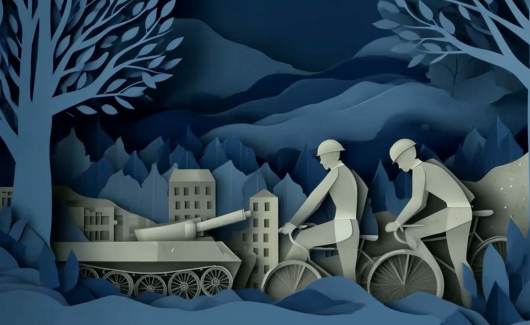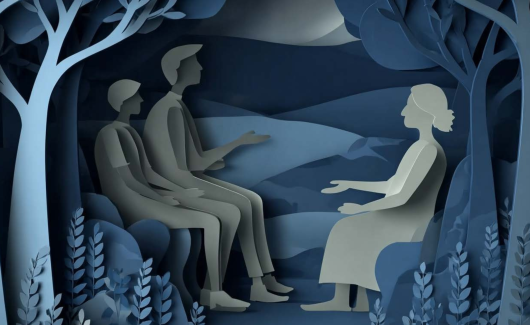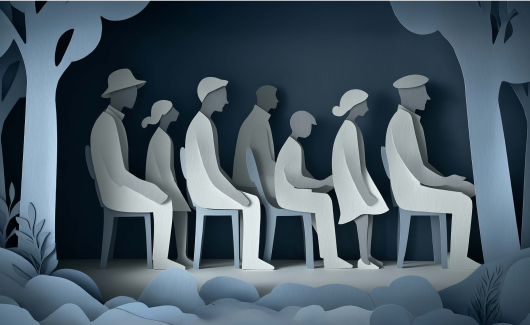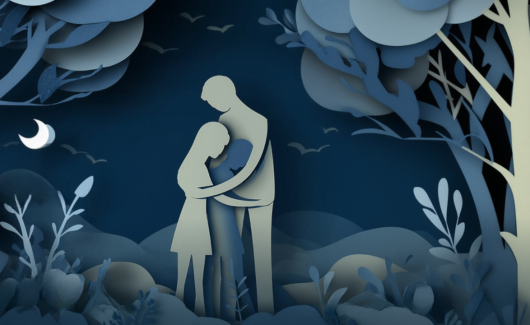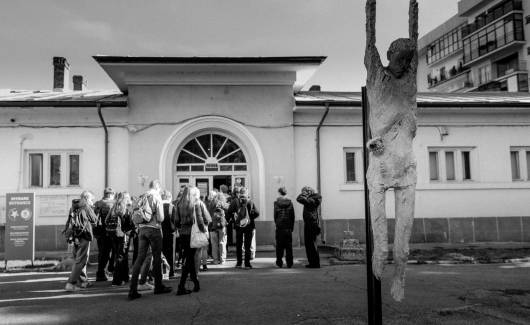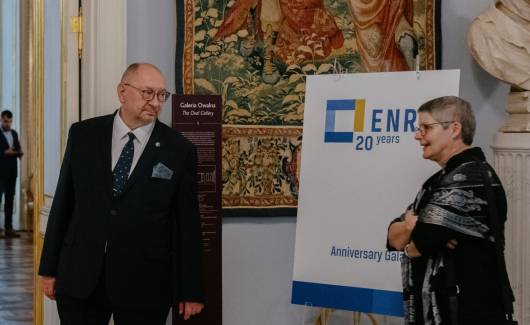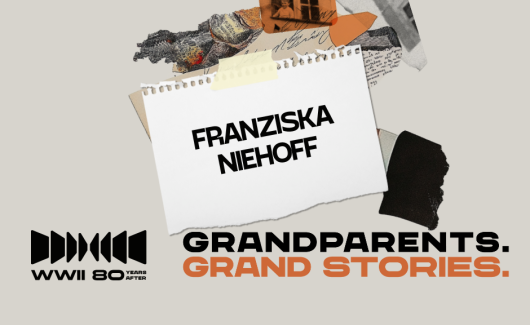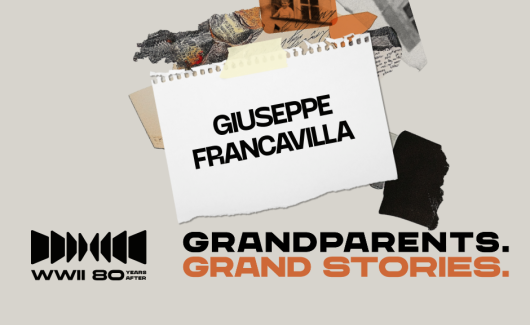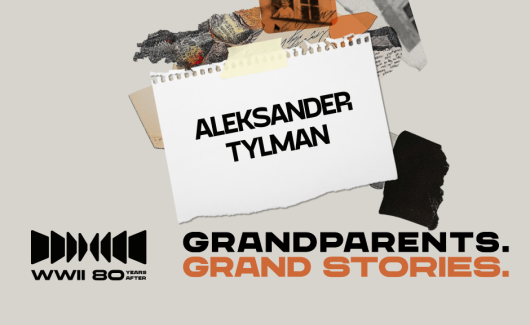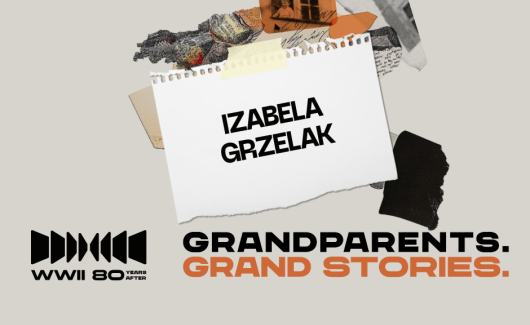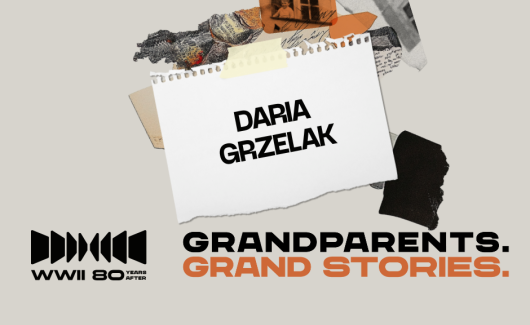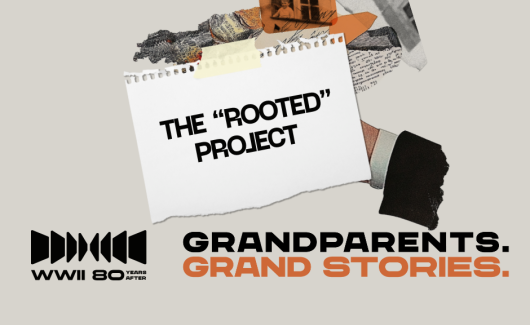23 sierpnia przypada Europejski Dzień Pamięci Ofiar Reżimów Totalitarnych – dzień, w którym oddajemy hołd tym, którzy cierpieli w wyniku przemocy systemów totalitarnych XX wieku. Systemów opartych na przemocy, represji i ideologicznym zniewoleniu. Tegoroczna kampania koncentruje się na traumie międzypokoleniowej – jednym z najbardziej złożonych aspektów dziedzictwa historycznego. Choć nie zostawia ona widocznych ran, ale jak się okazuje potrafi przenikać przez pokolenia i wpływać na całe społeczeństwa – kształtując relacje, tożsamość, sposoby myślenia i reagowania.
Do refleksji nad tym tematem zaprosiliśmy wybitnego badacza: prof. Michała Bilewicza, psychologa społecznego i autora książki Traumaland, poświęconej pamięci zbiorowej i społecznym skutkom przemocy.
Prof. Bilewicz był także gościem naszego cyklu dyskusji „Zrozumieć Pamięć” w kwietniu 2024 roku, gdzie wraz z Katarzyną Surmiak-Domańską (autorką książki Czystki) omawiał m.in. swoją książkę Traumland – nagranie dostępne jest na YouTube.
ENRS, Mariola Cyra: Czym jest trauma międzypokoleniowa?
Profesor Michał Bilewicz: W psychologii trauma międzypokoleniowa to zjawisko przekazu doświadczeń traumatycznych z jednego pokolenia na kolejne – i to nie tylko w sensie narracyjnym, ale głównie w wymiarze psychicznym, wpływającym na zdrowie psychiczne potomków. Zjawisko to zaczęto intensywnie badać w latach 70. i 80., szczególnie w Izraelu. Wówczas zauważono, że weterani powracający z wojny w Libanie, których rodzice byli ocalałymi z Holokaustu, wykazywali znacznie silniejsze objawy zespołu stresu pourazowego (PTSD) niż ci, których rodzice nie mieli takich doświadczeń. Badania prowadzone wówczas przez Solomon, Kotlera i Mikulincera pokazały, że trauma może wpływać na wrażliwość kolejnych pokoleń na stresory – sprawiając, że reagują one silniej na nowe, trudne sytuacje.
W Izraelu do dziś prowadzi się wiele systematycznych badań nad tym zjawiskiem. Istnieje tam m.in. panel badawczy, w którym uczestniczą osoby będące potomkami ocalałych z Holokaustu, a także osoby o identycznym profilu demograficznym, ale pochodzące z rodzin bez takich doświadczeń – np. tych, które w czasie wojny przebywały na terenie byłego Związku Radzieckiego czy Bliskiego Wschodu. Badani są regularnie, zarówno w codziennych warunkach, jak i w momentach kryzysów. W sytuacjach stresowych wyraźnie widać różnice – potomkowie ocalałych częściej doświadczają pogorszenia nastroju, lęku, objawów depresyjnych czy PTSD.
Jednocześnie metaanalizy profesora van IJzendoorna, pokazują, że w codziennych warunkach nie ma istotnych różnic w zdrowiu psychicznym pomiędzy potomkami ofiar traumy a osobami z rodzin bez takich doświadczeń. Różnice pojawiają się dopiero w odpowiedzi na stresory – i to właśnie ta zwiększona wrażliwość na zagrożenie jest jednym z kluczowych mechanizmów traumy międzypokoleniowej.
Oczywiście to kliniczne rozumienie zjawiska to tylko jedna z perspektyw. Mnie osobiście interesują również społeczne konsekwencje takiej traumy – takie jak wzmożona nieufność, skłonność do wierzenia w teorie spiskowe, nadwrażliwość czy lękowość. To cechy, których nie da się sprowadzić wyłącznie do zaburzeń psychicznych – są one raczej przejawem specyficznego funkcjonowania społecznego, ukształtowanego przez dziedzictwo przeszłych traum.
W jakim stopniu reżimy totalitarne odcisnęły piętno nie tylko na historii, ale i na psychice społeczeństwa? Czy możemy mówić o społeczeństwach po traumie?
Tak, zdecydowanie możemy mówić o takich społeczeństwach. W psychiatrii transkulturowej, ale też coraz częściej również w psychologii, używa się w tym kontekście pojęcia traumy historycznej, które różni się od traumy transgeneracyjnej. Ta druga odnosi się głównie do efektów psychologicznych lub psychiatrycznych przenoszonych z pokolenia na pokolenie. Natomiast trauma historyczna to szersze zjawisko, obejmujące sposoby, w jakie społeczeństwa adaptują się do skrajnych doświadczeń – wojny, okupacji, czystek etnicznych czy ludobójstwa – i jak te adaptacje utrzymują się nawet wtedy, gdy warunki zewnętrzne ulegają zmianie.
Po zakończeniu wojny czy po upadku reżimu ludzie formalnie wracają do normalnego życia, ale ich funkcjonowanie społeczne nadal nosi ślady tamtych doświadczeń. Widzimy to na przykład w utrwalonej nieufności – szczególnie wobec obcych, przedstawicieli innych narodów czy państw. Obawy i lęki pojawiają się łatwo i silnie rezonują, zwłaszcza jeśli dotyczą dzieci czy kobiet – czyli grup, które były szczególnie narażone na przemoc w przeszłości. W społeczeństwach, które doświadczyły masowej śmierci dzieci, gwałtów czy innych form przemocy na dużą skalę, zagrożenia tego typu uruchamiają bardzo silne reakcje – znacznie silniejsze niż w społeczeństwach, które nie przeszły przez tego rodzaju traumę.
Choć trauma międzypokoleniowa odnosi się do doświadczeń przeszłych pokoleń, jej skutki bywają odczuwalne także przez tych, którzy sami nie przeżyli wojny, represji czy prześladowań. Jak to się dzieje?
To bardzo ciekawe zjawisko, które dobrze opisali Michael Wohl i Jay van Bavel, prowadząc badania wśród kanadyjskich Żydów. Zauważyli oni, że objawy traumy transgeneracyjnej pojawiały się również u osób, które nie miały wśród swoich przodków bezpośrednich ofiar Holokaustu – ich rodziny mieszkały już w Kanadzie w czasie wojny. Kluczowym czynnikiem okazała się tutaj nie historia rodzinna, lecz siła identyfikacji ze wspólnotą. Osoby, które silnie utożsamiały się ze społecznością żydowską, wykazywały wyraźniejsze objawy traumy transgeneracyjnej.
To pokazuje, że przekaz traumy nie ogranicza się wyłącznie do relacji rodzinnych. Oczywiście, istnieje hipoteza o epigenetycznym transferze traumy – czyli biologicznej adaptacji dziedziczonej przez kolejne pokolenia – ale jak dotąd mamy na to niewiele twardych dowodów. Znacznie lepiej udokumentowany jest przekaz kulturowy czy społeczny.
Trauma może być przekazywana przez rodzinne opowieści, milczenie, zachowania rodziców, ale także przez edukację, media, rytuały pamięci czy obchody rocznic. Przekaz kulturowy – to, co mówi się (lub czego się nie mówi) o przeszłości w danej wspólnocie – może kształtować postrzeganie historii w takim samym stopniu, jak indywidualne doświadczenia rodzinne. To właśnie ten społeczny wymiar traumy sprawia, że nawet osoby bez osobistych związków z przeszłą tragedią mogą ją odczuwać jako część własnej tożsamości i reagować na nią emocjonalnie.
Czy osoby urodzone po 1990 roku, które dorastały w wolnej Europie, mogą nieść w sobie emocjonalne dziedzictwo systemów totalitarnych? Jak to się objawia – w relacjach, tożsamości, języku?
To, jak funkcjonuje młodsze pokolenie Polaków – zwłaszcza tych urodzonych po 1989 roku – jest rzeczywiście bardzo ciekawe i czasami wręcz zaskakujące. W badaniach mojego doktoranta, Damiena Stewarta – Australijczyka, który analizował zjawisko traumy transgeneracyjnej w Polsce – pojawiła się intrygująca obserwacja: najwyższy poziom objawów transgeneracyjnego PTSD nie występuje wśród dzieci osób, które przeżyły okupację, ale właśnie w trzecim pokoleniu, czyli u wnuków tych, którzy doświadczyli wojny. To zaskakujące zjawisko pokazuje, że trauma może wracać z pewnym opóźnieniem.
To pokolenie dorastało już w realiach transformacji i wolnej Polski, ale też w okresie pewnego renesansu pamięci traumatycznej, który rozpoczął się na początku obecnego tysiąclecia, wraz z powstaniem Muzeum Powstania Warszawskiego, a później z intensyfikacją narracji o Żołnierzach Wyklętych. Pamięć o wojnie i przemocy zaczęła wtedy mocno powracać do przestrzeni publicznej – w kulturze masowej, muzeach, edukacji.
Jak kultura masowa, pomniki, narracje muzealne czy podręczniki szkolne mogą przyczynić się do uzdrawiania albo – przeciwnie – pogłębiania traumy?
Jeśli przyjrzymy się podręcznikom czy lekturom szkolnym, zobaczymy, że młodzież poznaje historię okupacji najczęściej przez opowiadania Tadeusza Borowskiego – teksty niezwykle trudne, ukazujące ekstremalnie zdegradowany świat obozów, ludzi, którzy utracili wolę życia, stali się tzw. „muzułmanami” w języku obozowym, czy – w literaturze łagrowej – dochodjaga. To są jednostki wyniszczone psychicznie i fizycznie – na granicy życia i śmierci.
Tymczasem takie obrazy, choć prawdziwe, dotyczą skrajnych przypadków. Historia okupacji to także ludzie, którzy mimo wszystko próbowali żyć, funkcjonować, przystosować się – w ekstremalnych warunkach, ale jednak zachować człowieczeństwo. Niestety, edukacja często przedstawia właśnie ten najbardziej mroczny wycinek jako normę, co prowadzi do zniekształcenia obrazu przeszłości.
Do tego dochodzą dziś techniki immersyjne – coraz częściej wykorzystywane w edukacji czy muzealnictwie. Uczniowie i uczennice wcielają się w postacie ofiar, uczestniczą w realistycznych grach, doświadczeniach VR. To może być skuteczne edukacyjnie, ale niesie też ryzyko przeciążenia psychicznego.
W badaniach, które prowadziłem wśród młodzieży odwiedzającej Muzeum Auschwitz-Birkenau, okazało się, że kilkanaście procent uczniów wykazywało miesiąc po wizycie objawy charakterystyczne dla PTSD – trudności z zasypianiem, nadwrażliwość, powracające obrazy, koszmary. Właśnie dla tych młodych ludzi trzeba zadać sobie pytanie: Jak sprawić, by kontakt z miejscem pamięci był doświadczeniem edukacyjnym, a nie traumatyzującym? Pamięć o przeszłości nie może polegać wyłącznie na szoku – jej celem powinno być zrozumienie, refleksja i możliwość włączenia tej wiedzy w zdrową tożsamość.
Jak więc rozmawiać z dziećmi o bolesnych aspektach historii, skoro nawet wizyta w muzeum może wywoływać tak silne reakcje? Co warto przekazywać, a czego unikać?
Nie uważam, żebyśmy powinni unikać trudnych tematów czy filtrować fakty historyczne – to byłoby nieuczciwe. Równie niebezpieczne jest epatowanie okrucieństwem, koncentrowanie się wyłącznie na najbardziej skrajnych i dramatycznych doświadczeniach, które – choć prawdziwe – nie były codziennością większości ludzi.
Kluczowe jest pokazanie sprawczości. To znaczy: opowiadanie o tym, że nawet w najbardziej ekstremalnych warunkach ludzie próbowali sobie radzić, podejmowali wysiłki, by zachować godność, pomagać innym, stawiać opór – niekoniecznie z bronią w ręku. Często był to opór cichy, cywilny. Dla niektórych formą oporu była religia, dla innych kultura, wartości, więzi rodzinne.
Tymczasem w naszej edukacji – w szkołach czy muzeach – dominuje narracja heroiczna: opór zbrojny, powstania, partyzantka. Rzadko mówi się o codziennych formach przetrwania: o tym, że ktoś przewoził mięso ze wsi do miasta, dzięki czemu był w stanie utrzymać swoją rodzinę; że ktoś przechowywał książki zakazane przez okupanta albo prowadził tajne nauczanie. To są historie, które często funkcjonują w rodzinach, ale nie są przekazywane dalej, bo nie uchodzą za „bohaterskie”. A to właśnie one mają ogromny potencjał edukacyjny – pokazują, jak ludzie potrafili zachować człowieczeństwo, działać, troszczyć się o innych mimo przemocy i strachu.
Dzieciom warto przekazywać nie tylko to, że istniało zło i cierpienie, ale również, że ludzie mieli wybór, że potrafili być solidarni, że walczyli o przetrwanie – i że ta historia nie jest tylko historią ofiar, ale też historii przetrwania i odwagi w codzienności. To pomaga zbudować odporność, a nie tylko lęk.
Czy to nie milczenie najmocniej kształtuje kolejne pokolenia? Czy nie milczymy zbyt często? Pytam o to też osobiście – jestem prawnuczką oficera zamordowanego w Katyniu. O historii, która wpłynęła na losy naszej rodziny, niewiele się mówiło.
Zdecydowanie warto zadawać pytania – i szczególnie ważne jest, gdy robi to pokolenie wnuków, to trzecie pokolenie. Dzieciom znacznie trudniej rozmawiać z własnymi rodzicami o traumatycznych doświadczeniach niż wnukom z dziadkami. Między wnukami a dziadkami jest często więcej przestrzeni emocjonalnej, więcej ciekawości niż oporu.
Równie ważne jak pytanie, jest to, co zrobimy, kiedy pojawi się odpowiedź. Czy jesteśmy gotowi naprawdę wysłuchać? Wiele osób z pokolenia ofiar próbowało mówić – tylko nikt nie chciał ich słuchać. W efekcie wiele osób wycofało się z tych prób. Często szukali wspólnoty wśród ludzi z podobnym doświadczeniem – stąd powstały takie środowiska jak Kluby Auschwitz, Buchenwaldu, Stutthofu. Te nazwy mogą dziś brzmieć makabrycznie, ale to były realne próby stworzenia przestrzeni, gdzie można nie tyle mówić o traumie wprost, ile po prostu być z ludźmi, którzy rozumieją bez słów.
W przypadku rodzin katyńskich milczenie było wręcz wymuszone. Przez wiele lat mówienie o Katyniu mogło być nie tylko społecznie wykluczające, ale i niebezpieczne. To trauma zepchnięta w cień – nie tylko osobisty, ale też polityczny. Wiem, że prowadzone były badania nad tym, jak te rodziny funkcjonowały po wojnie – jak pamięć została w nich zamrożona, przekazywana pośrednio, przez emocje, zachowania, a nie słowa.
Dopiero lata 90. i 2000. przyniosły coś w rodzaju społecznego uznania dla tej pamięci. Pojawiły się filmy, takie jak Katyń Wajdy, które dały wielu rodzinom poczucie, że wreszcie można mówić. I że ktoś wreszcie słucha.
Na ile sztuka – literatura, film, teatr, fotografia – może pomóc w leczeniu traumy międzypokoleniowej?
Sztuka może pełnić bardzo istotną rolę w procesie oswajania i przepracowywania traumy. Czasem robi to w sposób paradoksalny. Jeśli przyjrzymy się pierwszym powojennym filmom dotyczącym okupacji, to zaskakująco często mamy do czynienia z komedią. Filmy takie jak Zezowate szczęście czy Jak rozpętałem drugą wojnę światową były sposobem, w jaki pokolenie, które samo przeżyło wojnę, próbowało z nią sobie poradzić. Wyśmiewanie pewnych zachowań czy sytuacji pozwalało nabrać dystansu – i właśnie ten dystans bywa niezbędny, by móc jakoś zintegrować trudne doświadczenia.
Podobnie jest z innymi reakcjami, które z zewnątrz mogą wydawać się niestosowne czy wręcz bulwersujące – jak śmiech, żarty, korzystanie z telefonu w miejscach pamięci, na przykład w Auschwitz. Badamy te zjawiska i okazuje się, że one często pełnią funkcję obronną. Ludzie próbują oswoić coś, co jest niemal nie do zniesienia.
Taki nurt obecny był także w tzw. kinie Holokaustu. Filmy takie jak Pociąg życia czy Życie jest piękne – podejmują próbę mówienia o zbrodni w sposób, która nie tylko przekazuje wiedzę, ale też pozwala widzowi choć trochę złagodzić emocjonalne obciążenie.
Trzeba jednak pamiętać, że kultura ma też swoją ciemniejszą stronę. Może również traumatyzować. Z badań, które prowadziliśmy m.in. wśród polskich Żydów, a także z analiz Michaela Wohla i Jaya Van Bavel'a, wiemy, że bardzo silna identyfikacja z grupą niesie w sobie dziedzictwo traumy. Może sprawiać, że człowiek doświadcza traumy wtórnej. Kultura, która stale przypomina o cierpieniu i przemocy, może wzmacniać poczucie zagrożenia, izolacji, lęku. Kluczowe jest więc, jak mówimy o przeszłości – i czy dajemy odbiorcy możliwość wejścia w ten świat z zachowaniem własnych granic.
Czy trauma może nas czegoś nauczyć? Empatii, odpowiedzialności, wolności?
Myślę, że trauma może nas czegoś nauczyć – choć niekoniecznie tego, czego byśmy oczekiwali. W pewnym sensie trauma przygotowuje nas na kolejne kryzysy. Prowadzi do nadwrażliwości, nieufności, które w czasie pokoju bywają destrukcyjne, ale w sytuacjach zagrożenia okazują się adaptacyjne. Widać to było choćby po wybuchu wojny w Ukrainie w 2022 roku. Polacy nie czekali na działania państwa, tylko oddolnie ruszyli z pomocą uchodźcom. To typowe zachowanie dla społeczeństwa, które ma w pamięci traumę – nawet jeśli nigdy jej wprost nie nazwało.
Z podobnym mechanizmem mamy do czynienia w kontekście życia w stałym zagrożeniu, jak w Izraelu czy Ukrainie. Tam ludzie uczą się funkcjonować w rzeczywistości alarmów, nalotów, przerw w dostawie prądu. A jednocześnie w krańcowej nieufności wobec obcych. Socjolog Daniel Bar-Tal nazywa to „etosem konfliktu” – codziennym sposobem życia w realiach wojny. To coś, co z zewnątrz może się wydawać nieludzkie, ale dla osób żyjących w takich warunkach staje się nową normą.
I może to właśnie pozwala nam lepiej zrozumieć, jak funkcjonowało pokolenie, które żyło pod okupacją. Dla nich widok egzekucji, getta, pacyfikacji – był czymś, z czym musieli się oswoić, żeby przeżyć. W tym sensie, jak pisał Miłosz, karuzela kręci się dalej – nie dlatego, że ludzie są obojętni, ale dlatego, że muszą żyć. To nie cynizm, lecz psychologicznie adaptacyjny mechanizm. Może nas to oburzać, ale tak działa ludzka psychika.
Co chciałby Pan zmienić w tym, jak społeczeństwa odnoszą się do swojej przyszłości?
Jest jedna rzecz, która wydaje mi się szczególnie ważna i która mogłaby się zmienić. W społeczeństwach historycznie straumatyzowanych bardzo często brakuje zdolności do uznania traum innych. Kiedy sami doświadczyliśmy cierpienia – zwłaszcza jeśli nasza trauma nie została w pełni uznana przez świat – pojawia się silna potrzeba skupienia na własnym bólu. Tak silna, że zaczynamy zaprzeczać traumom innych.
Dla mnie osobiście pisanie Traumaland było pewnego rodzaju ćwiczeniem empatii. Pochodzę z rodziny ocalałych z Holokaustu – większość mojej rodziny zginęła podczas Zagłady. Dorastałem w środowisku, w którym trauma żydowska była najważniejsza – inne cierpienia, w tym wojenne doświadczenie Polaków nie będących Żydami traktowano jako mało doniosłe. Kiedyś pisał o tym Henryk Grynberg, że w wypadku Żydów zdziesiątkowanie znaczy, że co dziesiąty przeżył – zaś w wypadku Polaków, że co dziesiąty zginął. I że te dwa okupacyjne doświadczenia są zupełnie nieporównywalne. A przecież stracenie 10% całej populacji to ogromna, historyczna rana. I ona również zasługuje na uznanie.
Podobny mechanizm działa też w odwrotną stronę – wielu Polaków, skoncentrowanych na własnej traumie, nie jest gotowych uznać bólu innych: Ukraińców, Niemców, Żydów. Niechętnie mówi się o zbrodniach popełnionych przez Polaków – czy to w czasie Holokaustu, czy po wojnie: w obozach w Świętochłowicach, Łambinowicach, podczas akcji „Wisła”. A przecież bycie ofiarą w przeszłości nie wyklucza bycia sprawcą w przyszłości.
W historii ludobójstw i przemocy widać jasno: sprawcy bardzo często wcześniej byli ofiarami. To bolesna prawda. Trauma – jeśli nie zostanie przepracowana – może prowadzić do gotowości traumatyzowania innych. Dlatego potrzebujemy perspektywy psychologicznej, skoncentrowanej na indywidualnym doświadczeniu, a nie na narodowej narracji.
Psychologia, w przeciwieństwie do historii czy politologii, nie tworzy opowieści uzasadniających rację jednej strony. Ona daje przestrzeń każdemu – bo każda trauma, by mogła zostać uleczona, musi zostać uznana. I to uznanie jest, moim zdaniem, naszą największą nadzieją.
Dlaczego defensywne narracje są tak powszechne? Czy to naturalne, że wolimy widzieć siebie tylko jako ofiary?
Tak, to dość naturalny mechanizm psychologiczny. W psychologii mówimy o moral typecasting – mamy tendencję, by postrzegać ludzi w sztywnych rolach: albo ofiara, albo sprawca. Bardzo trudno jest pogodzić się z tym, że ktoś może być i jednym, i drugim. Im silniej budujemy własną tożsamość na roli ofiary, tym trudniej przyjąć, że mogliśmy również być sprawcami. Tylko w nielicznych przypadkach, takich jak Niemcy po II wojnie światowej czy Rwanda po ludobójstwie, udało się stworzyć przestrzeń do przyznania się do tej trudnej podwójności.
Historia i doświadczenia nie są czarno-białe. Wystarczy spojrzeć na przykład Kaszub czy Pomorza – przed wojną ludzie żyli obok siebie, granice były inne. Podziały na oprawców i ofiary nie są jednoznaczne.
Dokładnie tak. I to pokazuje niebezpieczeństwo narodowej unifikacji narracji historycznej. W psychologii postrzegamy ją jako bardzo szkodliwą, bo uniemożliwia indywidualną ekspresję i opowiedzenie osobistego doświadczenia. Doskonale widać to dziś przy okazji wystawy Nasi chłopcy, która wywołała skrajne reakcje – często pełne niewiedzy i ignorancji. Wiele osób nie zdaje sobie sprawy, że przymusowo do Wehrmachtu wcielono setki tysięcy Polaków – więcej, niż walczyło w Armii Krajowej. A mimo to losy tych ludzi są wypierane, niepożądane w dominującej narracji.
To nie jest jednak kwestia ucieczki od odpowiedzialności. To efekt tego, że polska pamięć historyczna została skolonizowana – najpierw przez jeden region, czyli Polskę Centralną, a potem przez jedną klasę społeczną – polską inteligencję. I to doświadczenie tej klasy, tej geografii, zostało rozciągnięte na całą Polskę, wypierając inne historie. Historię ludzi z Kaszub, z Pomorza, z Galicji. Ludzi, którzy nie zawsze mogli się wpisać w heroiczne, insurekcyjne narracje.
Dla mnie, jako psychologa, to właśnie indywidualne doświadczenia – ludzi, rodzin – powinny stać się punktem wyjścia. Tylko wtedy możliwe jest prawdziwe uznanie i przepracowanie traumy. A nie poprzez narzucane z góry narracje, które dzielą historię na czarne i białe pola.
Czy są kraje lub społeczności, które Pana zdaniem poradziły sobie z traumą, z trudną przeszłością?
Paradoksalnie – im bardziej społeczeństwo było straumatyzowane, tym trudniej mu się z tą traumą uporać. Nie potrafię wskazać narodu, który rzeczywiście w pełni „przepracował” swoją przeszłość. Żeby ta praca była możliwa, musi istnieć jakiś punkt wyjścia – uznanie sprawstwa, nazwanie zbrodni po imieniu. Dobrym przykładem są Niemcy czy Rwanda. W obu przypadkach mamy do czynienia z oficjalnym uznaniem ludobójstwa i jego sprawców, co pozwoliło zbudować zupełnie nową narrację – zarówno edukacyjną, jak i społeczną.
W Niemczech Holokaust stał się absolutnym centrum pamięci historycznej. Badania, takie jak MEMO-Studie zespołu z Uniwersytetu w Bielefeld, pokazują, że większość Niemców zna historię swojego kraju właśnie od momentu narodowego socjalizmu – wcześniejsze epoki są niemal nieobecne w zbiorowej świadomości. Nauczanie o Holokauście nie jest tam kwestionowane – wręcz przeciwnie, jest fundamentalnym elementem tożsamości obywatelskiej.
Podobnie w Rwandzie – po ludobójstwie całkowicie zerwano z tożsamościami plemiennymi. Dziś młode pokolenie nie wie, czy ich rodziny należały do Hutu, Tutsi czy Twa. System sprawiedliwości, w tym sądy Gacaca, nie tylko karał sprawców, ale też dążył do pojednania lokalnych wspólnot, które musiały nadal żyć razem. I w tym sensie można mówić o sukcesie wewnętrznej odbudowy.
Kiedy jednak spojrzymy szerzej – na relacje Rwandy z Demokratyczną Republiką Konga, czy na kwestie stosunku Niemców ze wschodniej części kraju do uchodźców – to pojawiają się rysy. Rwanda wspiera zbrojne działania poza swoimi granicami, a w Niemczech rośnie popularność AfD (niem. Alternative für Deutschland) i nastroje antyimigranckie. Można więc zadać pytanie, czy ten sukces pamięci – uznania własnej traumy – rzeczywiście przekłada się na szersze społeczne funkcjonowanie. A może coś zostało wyparte – i teraz właśnie wraca w innej formie. Dr. Fiona Kazarovytska z Uniwersytetu w Moguncji pokazuje, że Niemcy, którzy są szczególnie dumni z tego, jak ich naród rozliczył się z przeszłością, mają tendencję do traktowania historii narodowego socjalizmu jako zamkniętego rozdziału – co w efekcie czyni ich dzisiaj bardziej podatnymi na wszelkie ksenofobiczne czy rasistowskie ideologie.
To wszystko pokazuje, że przepracowanie traumy to nie zamknięty proces, tylko ciągłe zadanie – także dla przyszłych pokoleń.
Od czego zacząć zmianę, by kolejne pokolenia były bardziej świadome, dojrzałe, inaczej myślały o swojej przeszłości?
Myślę, że punktem wyjścia powinno być przeformułowanie naszej opowieści o przeszłości. Polska tożsamość historyczna jest dziś w dużej mierze oparta na obrazie cierpienia i moralnej niewinności – postrzegamy siebie przede wszystkim jako bierne ofiary. Tymczasem historia była znacznie bardziej złożona. Potrzebujemy narracji, która pokazuje sprawczość – także w najtrudniejszych czasach. Trzeba przypominać, że nie wszyscy byli bierni, że byli ludzie, którzy działali, opierali się, ale też, że różne były postawy – również takie, które wymykają się wygodnej opowieści o wyłącznie moralnych ofiarach.
Jak rozmawiać z młodymi ludźmi o traumatycznych kartach historii, by nie budzić w nich oporu ani poczucia oskarżenia? Jak przełamać to koło zazębiającej się traumy?
Kluczem jest pokazywanie złożoności historii – unikanie czarno-białych narracji. Trzeba mówić o cierpieniu i niesprawiedliwości, ale nie tylko przez pryzmat sprawców i ich ofiar. Warto kierować uwagę także na tych, którzy ocaleli – na ich wybory, decyzje, sposoby radzenia sobie. Na tych, którzy w sytuacjach granicznych wykazywali sprawczość, choćby w najdrobniejszy sposób.
Zamiast przedstawiać młodym ludziom historię jako opowieść o winie i oskarżeniu, warto ukazywać ją jako przestrzeń refleksji nad losem jednostki – nad tym, jak ludzie reagowali w skrajnych warunkach. Tylko wtedy możemy liczyć na prawdziwe zrozumienie, empatię – i przełamanie tego mechanizmu przenoszenia traumy z pokolenia na pokolenie.
Michał Bilewicz – psycholog społeczny i polityczny, profesor Uniwersytetu Warszawskiego, gdzie kieruje Centrum Badań nad Uprzedzeniami. Zajmuje się psychologicznymi mechanizmami pojednania, pamięci zbiorowej, traumy i uprzedzeń. Autor książki Traumaland. Polacy w cieniu przeszłości.

